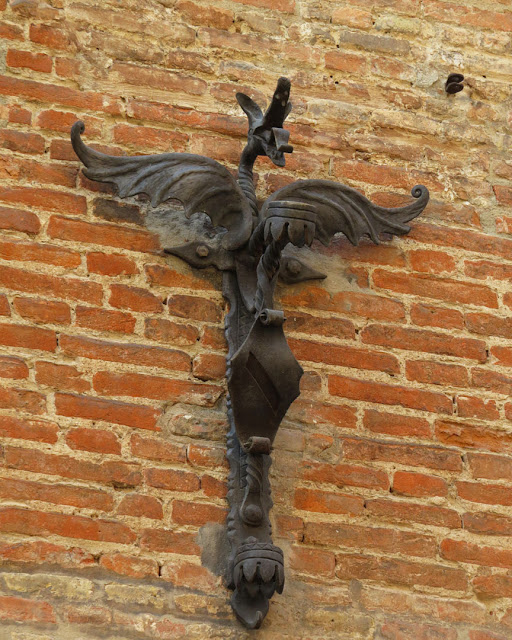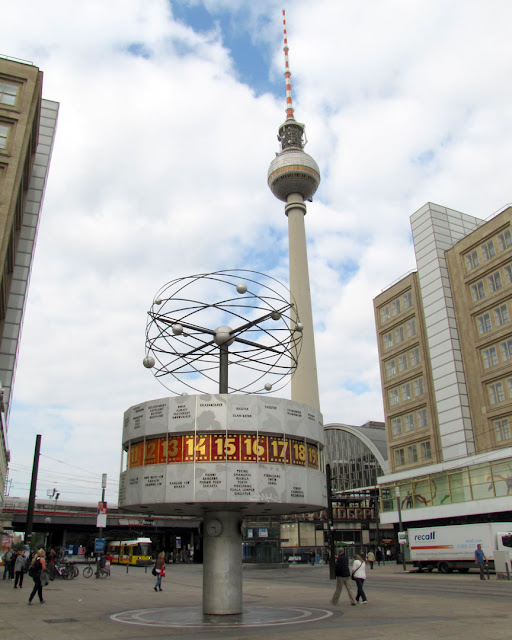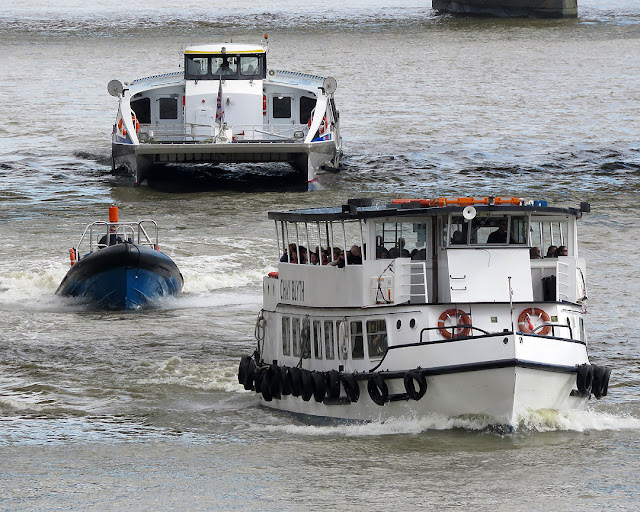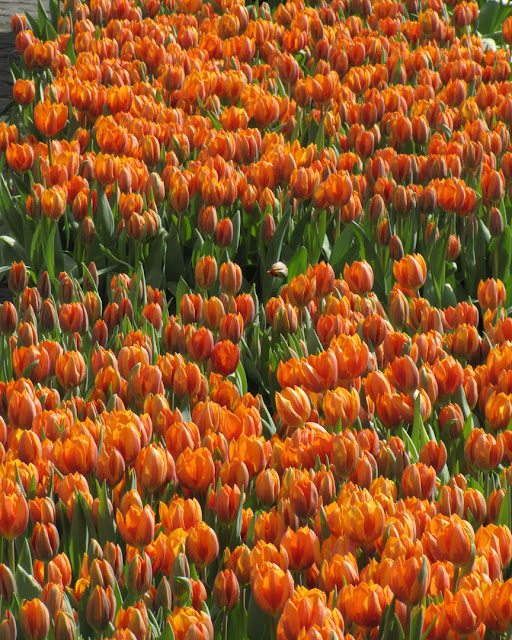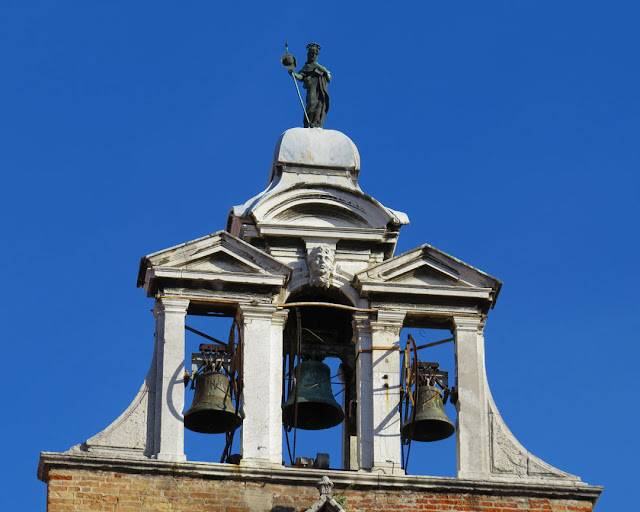Wednesday, November 30, 2016
Vélib' Station
Vélib' station
Cours de Vincennes
Quartier du Bel-Air, 12th arrondissement
Paris, July 2014
“Vélib' is a large-scale public bicycle sharing system in Paris, France. Launched on 15 July 2007, the system encompasses around 14,500 bicycles and 1,230 bicycle stations, located across Paris and in some surrounding municipalities, with an average daily ridership of 85,811 in 2011. The name Vélib' is a portmanteau of the French words vélo (bicycle) and liberté (freedom). Vélib' is operated as a concession by the French advertising corporation JCDecaux. As of 2014, Vélib' is the world's 12th-largest bikesharing program by the number of bicycles in circulation; the rest of the top 18 are in Chinese cities.” (Vélib', Wikipedia)
Tuesday, November 29, 2016
Monday, November 28, 2016
Sphere Within Sphere
Sphere Within Sphere (Sfera con sfera) by Arnaldo Pomodoro, 1996
Headquarters of the United Nations
United Nations Plaza
New York, September 2008
Sunday, November 27, 2016
Saturday, November 26, 2016
Tate Modern & Switch House
The Tate Modern and the new Switch House by Herzog & de Meuron
Seen from the Sky Garden at the 35th floor of Rafael Viñoly's “Walkie Talkie”
London, September 2016
“A ten-storey tower, 65 metres high from ground level, was built above the oil tanks. The original western half of the Switch House was demolished to make room for the tower and then rebuilt around it with large gallery spaces and access routes between the main building and the new tower on level 1 (ground level) and level 4. The new galleries on level 4 have natural top lighting. A bridge built across the turbine hall on level 4 to provides an upper access route. The new building opened to the public on 17 June 2016. The design, again by Herzog & de Meuron, has been controversial. It was originally designed with a glass stepped pyramid, but this was amended to incorporate a sloping façade in brick latticework (to match the original power-station building) despite planning consent to the original design having been previously granted by the supervising authority. The extension provides 22,492 square metres of additional gross internal area for display and exhibition spaces, performance spaces, education facilities, offices, catering and retail facilities as well as a car parking and a new external public space.” (Tate Modern, Wikipedia)
Friday, November 25, 2016
Scala Contarini del Bovolo
External spiral staircase by Giorgio Spavento
Palazzo Contarini del Bovolo
Calle Contarini del Bovolo, San Marco
Venezia, September 2013
“On the wall of the alley on the south side of Campo Manin, a sign directs you to the staircase known as the Scala del Bovolo – bovolo is the word for snail shell in Venetian dialect. External staircases, developed originally as a way of saving space inside the building, were a common feature of Venetian houses into the sixteenth century, but this specimen, dating from around 1500, is the most flamboyant variation on the theme.” (Jonathan Buckley, The Rough Guide to Venice & the Veneto)
Thursday, November 24, 2016
The Clock & the Tower
Urania-Weltzeituhr (Urania Worldtime Clock) by Erich John
Fernsehturm (Television tower) by Hermann Henselmann
Alexanderplatz
Berlin, September 2011
Wednesday, November 23, 2016
Tuesday, November 22, 2016
London Eye Capsule
A London Eye capsule with passengers
The Queen's Walk
South Bank, Lambeth
London, September 2016
“The wheel's 32 sealed and air-conditioned ovoidal passenger capsules, designed and supplied by Poma, are attached to the external circumference of the wheel and rotated by electric motors. Each of the 10-tonne (11-short-ton) capsules represents one of the London Boroughs, and holds up to 25 people, who are free to walk around inside the capsule, though seating is provided. The wheel rotates at 26 cm (10 in) per second (about 0.9 kph or 0.6 mph) so that one revolution takes about 30 minutes. It does not usually stop to take on passengers; the rotation rate is slow enough to allow passengers to walk on and off the moving capsules at ground level. It is, however, stopped to allow disabled or elderly passengers time to embark and disembark safely.” (London Eye, Wikipedia)
Monday, November 21, 2016
UniCredit Pavilion
UniCredit Pavilion by Michele De Lucchi, 2015
Piazza Gae Aulenti
Milan, November 2016
“The Unicredit Pavilion, created by Italian architect Michele de Lucchi, is a modular structure which aims to promote social functions and experimental activities, hosting cultural events, conferences, exhibitions and concerts. The structure, which can accommodate up to 700 people, is build adjacent to the Uni Credit’s headquarters in the Porta Nouva district in Milan.” (UniCredit Pavilion, Arch20)
Sunday, November 20, 2016
Viaduc d'Austerlitz
Viaduc d'Austerlitz (Austerlitz Viaduct), 1904
Quai de la Rapée / Quai d'Austerlitz
Quartier de la Salpêtrière, 13th arrondissement
Paris, July 2006
“Due to restrictions posed by navigational traffic, it was implausible to place a pier in the middle of the river. Therefore, in 1903, engineer Louis Biette, with the help of Fulgence Bienvenüe, conceptualized a metallic bridge that crossed the river in a single span. It was designed by the architect Jean-Camille Formigé, who also designed the Pont de Bir-Hakeim, the greenhouses of Auteiul, and the park below the Basilica of Sacré-Coeur, and restored the Roman amphitheater in Arles and the Roman theater in Orange. .[1] Formigé decorated the steel arcs with marine-themed reliefs, including dolphins, seashells and seaweeds. Parts of the steel footings are etched with figures of the Parisian Coat of Arms, which symbolizes steadfastness.” (Viaduc d'Austerlitz, Wikipedia)
Saturday, November 19, 2016
Palazzo Rosso
Palazzo Rosso (Red Palace)
Seen from the garden of Palazzo Doria-Tursi
Via Garibaldi
Genoa, April 2016
“Palazzo Rosso is a historical palace of Genoa, northern Italy. Situated in Via Garibaldi, it is one of the most important picture galleries of the city, along with the galleries of Palazzo Bianco and Palazzo Doria Tursi. Palazzo Rosso was designed by the architect Pietro Antonio Corradi and was built between 1671 and 1677. The Brignole Sale family owned the palace until 1874, when Maria Brignole Sale, duchess of Galliera, bequeathed it to the city of Genoa, in order to "increase its artistic splendor and practical resources". The palace then became municipal property and it was destined to become a public gallery.” (Palazzo Rosso, Wikipedia)
Friday, November 18, 2016
Thursday, November 17, 2016
Santo Spirito
Basilica di Santo Spirito (Basilica of the Holy Spirit)
Piazza Santo Spirito
Florence, April 2015
“Filippo Brunelleschi began designs for the new building as early as 1428. The first pillars to the building were delivered in1446, ten days before his death.[14] After his death in the works were carried on by his followers Antonio Manetti, Giovanni da Gaiole, and Salvi d'Andrea; the latter was also responsible for the construction of the cupola. Unlike S. Lorenzo, where Brunelleschi’s ideas were thwarted, here, his ideas were carried through with some degree of fidelity, at least in the ground plan and up to the level of the arcades.[15] The Latin cross plan is so designed to maximize the legibility of the grid. The contrast between nave and transept that caused such difficulty at S. Lorenzo was here also avoided. The side chapels, in the form of niches all the same size (forty in all), run along the entire perimeter of the space. Brunelleschi's facade was never built and left blank. In 1489, a columned vestibule and octagonal sacristy, designed by Simone del Pollaiolo, known as Il Cronaca, and Giuliano da Sangallo respectively, were built to the left of the building. A door was opened up in a chapel to make the connection to the church.” (Santo Spirito, Florence, Wikipedia)
Wednesday, November 16, 2016
Head
“Head” by Jun Kaneko, 2007
Park Avenue at 53rd Street
New York, September 2008
“Monumental heads by Nebraska-based Jun Kaneko delight passersbys from the traffic medians at 52nd, 53rd and 54th Streets on Park Avenue. The three heads depict an Asian man with a calm expression—the artist, or perhaps the face of Buddha. Kaneko created these richly glazed ceramic works in one of his signature walk-in ‘beehive kilns.’ The project was recommended by the Fund for Park Avenue Sculpture Committee, with support from Gebert Contemporary and the Grand Central Partnership.” (Jun Kaneko on Park Avenue, New York City Department of Parks & Recreation)
Tuesday, November 15, 2016
Heaven and Hell
“Heaven and Hell” fresco by Giovanni da Modena, 1410
Chapel of the Magi (once Bolognini Chapel)
Basilica of San Petronio
Piazza Maggiore
Bologna, June 2015
“In 2002, five men who it was believed were connected to Al Qaeda and were planning to blow up the building, were arrested. Again in 2006, plans by Muslim terrorists to destroy the Basilica were thwarted by Italian police. The terrorists claimed that a 15th-century fresco inside was insulting to Islam. The fresco, painted by Giovanni da Modena, depicts Muhammad in Hell being devoured by demons.” (San Petronio Basilica, Wikipedia)
Monday, November 14, 2016
Sunday, November 13, 2016
Saturday, November 12, 2016
Friday, November 11, 2016
Thursday, November 10, 2016
Wednesday, November 9, 2016
Galleria Vittorio Emanuele II
The glass dome of the Galleria Vittorio Emanuele II, by Giuseppe Mengoni, 1877
Piazza del Duomo
Milan, November 2016
“The structure consists of two glass-vaulted arcades intersecting in an octagon covering the street connecting Piazza del Duomo to Piazza della Scala. The street is covered by an arching glass and cast iron roof, a popular design for 19th-century arcades, such as the Burlington Arcade in London, which was the prototype for larger glazed shopping arcades, beginning with the Saint-Hubert Gallery in Brussels (opened in 1847), the Passazh in St Petersburg (opened in 1848), the Galleria Umberto I in Naples (opened in 1890) and the Budapest Galleria. The central octagonal space is topped with a glass dome. The Milanese Galleria was larger in scale than its predecessors and was an important step in the evolution of the modern glazed and enclosed shopping mall, of which it was the direct progenitor. It has inspired the use of the term galleria for many other shopping arcades and malls.” (Galleria Vittorio Emanuele II, Wikipedia)
Tuesday, November 8, 2016
Agatha Christie Memorial
“The Book” by Ben Twiston-Davies, 2012
A Memorial to Agatha Christie
Cranbourn Street / Great Newport Street
London, September 2016
“The idea of creating this wonderful Memorial to Agatha Christie was conceived and implemented by her grandson Mathew Prichard working with Stephen Waley-Cohen, Producer of The Mousetrap since 1994. They identified the ideal location for it at St Martin’s Cross, a major road junction which is also the main pedestrian route from Leicester Square to Covent Garden, in the heart of London’s Theatreland. Westminster City Council gave formal consent as well as offering consistently constructive advice. Everyone involved recognised the merit of a permanent Memorial to the world’s best-selling novelist and author of the world’s longest running stage production. The Memorial is in the form of a book, about 2.4 metres high, made in bronze, which appears to float above its base. It is lit from below as well as from within, and contains an over-life-size bust of Agatha Christie, as well as images of some of her greatest creations, and information about her life and work. It looks wonderful both in daylight and after dark. On the Memorial appear the following texts, together with titles of some of her most popular and famous books and plays, in English and some of the many other languages into which her work has been translated. The titles included were chosen in a competition among her fans.” (Agatha Christie Memorial)
Monday, November 7, 2016
Sunday, November 6, 2016
Half Broadgate Venus
Detail of the “Broadgate Venus” by Fernando Botero, 1989
Exchange Square
Broadgate, City of London
London, September 2016
Saturday, November 5, 2016
The Judgement
“Il Giudizio” (The Judgement) by Ugo Riva, 2011
Giardino della Gherardesca
Four Seasons Hotel Firenze
Florence, April 2015
Friday, November 4, 2016
Thursday, November 3, 2016
Wednesday, November 2, 2016
Für Das Kind
‘Für Das Kind’ (For the Children) by Flor Kent', 2003
Memorial to Kindertransport
Liverpool Street Station
London, September 2016
Tuesday, November 1, 2016
San Giacomo
Bell tower of San Giacomo di Rialto
Campo San Giacomo, San Polo
Venice, September 2013
“San Giacomo di Rialto, also known as San Giacometto, is believed to be the oldest church in Venice. With its typical cross plan, it was first built in 421, the year the city was founded according to tradition. The church we see today is the result of restoration work in 1601. The huge clock (1410) and the outstanding atrium with its Gothic portico are the two most distinctive features of this church. Money-changers and bankers used to sit under the portico, waiting for foreign currency or customers wishing to borrow. All banking transactions were conducted outdoors at the time, under the careful eye of the authorities. The concept of ‘exchange’ was born right here.” (Venice and its Lagoons, World Heritage)
See also: San Giacomo di Rialto - Il Gobbo di Rialto
Subscribe to:
Posts (Atom)




